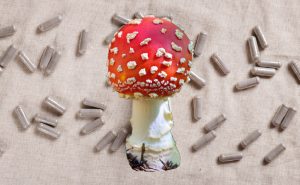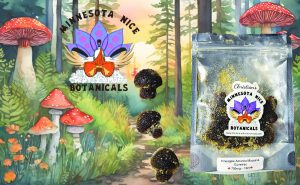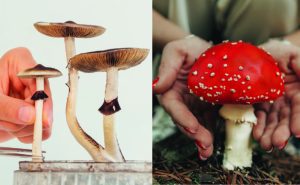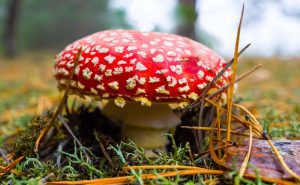Amanita Muscaria
There is much debate surrounding the psychoactive effects of Amanita muscaria, posing a question as to whether or not it is truly hallucinogenic. The Amanita muscaria is the iconic and most famous mushroom in history and mythology. Most people realize how significant a muscaria is, its iconic image is frequently used in modern media such as films, video games, novels, and artwork. It has been viewed as everything from the essential aspect of ancient primitive religions to an iconic video game symbol. The big question is, are amanita muscaria mushrooms hallucinogenic? Read on to learn more.
Mushrooms of the Agaricales order, like amanita muscaria (and the related amanita pantherina), can be found in many habitats throughout the Northern Hemisphere.
Coniferous forests like fir and black pine, as well as beech and birch forests, are ideal, but they can be found at lower altitudes and higher mountains. It typically occurs around the end of summer and peaks in the fall. The red cap and white dots make it easily recognizable, and the white stem is also a distinguishing feature.
Numerous alkaloids, including ibotenic acid and muscimol, give this fungus its psychedelic properties. It has been ingested as a recreational drug, utilized in shamanic rituals, and consulted for precognition since ancient times.
Amanita muscaria is a fungus that has the potential to induce hallucinations in people. Alternatively, it is known as the fly agaric or amanita phalloides. Due to their hallucinogenic properties, these mushrooms have been used as an intoxicant or entheogen for ages in shamanic rituals and other contexts.
Amanita muscaria is often regarded as one of the most potent mushrooms due to its reputation for inducing profound mystical experiences. Many small businesses have created very unique Amanita muscaria products. Take a peak at a few of our favorite Amanita muscaria inspired products from the boutique Amanita marketplace Inspire Uplift
The Amanita Muscaria Mushroom Effects
Some believe that the hallucinatory effects of the amanita muscaria mushroom are due to the psychoactive qualities that the fungus possesses. There is, however, scant data to back up this view.
The fly agaric (Amanita muscaria) is a species of the Amanita, including several toxic and psychedelic basidiomycete fungi. Amanita muscaria initially found only in the temperate and boreal zones of the Northern Hemisphere, is now considered a genuinely cosmopolitan species due to its accidental introduction to many nations in the Southern Hemisphere, usually as a symbiont with pine plantations.
Despite its reputation as a deadly plant, Amanita muscaria is more widely known for its hallucinogenic effects due to the presence of the chemical muscimol. Siberian culture attributes religious significance to the mushroom; ancient Indian and Scandinavian societies may have done the same.
Make sure to read our article about the Genus Amanita for in depth information about the genus Amanita, “What Is The Genus Amanita?”
The hallucinogenic effects of Amanita muscaria in humans have been studied extensively, including visual and auditory hallucinations and changes in perception and spatial awareness. These symptoms often wear off after 30 minutes to 2 hours, although they might linger for as long as 6 hours in rare instances.
Some claim that Amanita muscaria’s hallucinogenic effects can be attributed to its psychedelic qualities. There is, however, scant empirical data to back up this view. However, the hallucinogenic effects of the mushroom are more likely due to its psychoactive qualities and the presence of muscimol.
Legal Status of Amanita Muscaria Mushrooms
In most regions, amanita muscaria and other amanita species are completely legal to cultivate (grow), distribute and consume. However, ownership, acquisition, and distribution are all illegal in Australia, Romania, The Netherlands and Thailand. Once legal to collect and sell, amanita muscaria has been off-limits in Romania since 2010. Previously, it could be purchased online or in specialty stores. Amanita Muscaria mushrooms are legal to cultivate, possess and consume in the United States of America, with the exception of Louisanna, it’s only allowed for ornamental purposes, growing, selling or possessing Amanita muscaria is prohibited by Louisiana State Act 159. We encourage people to check their local laws before considering cultivating (growing), processing or distributing amanita muscaria mushrooms.
Our article, “Is the Amanita Muscaria Mushroom a Drug?” examines the legal status of Amanita Muscaria mushrooms throughout the world.
How To Identify Amanita Muscaria?
It’s crucial to correctly identify mushrooms, as their toxicity varies significantly depending on species and cultivar. Several species, including the potentially fatal Amanita phalloides, can easily be mistaken for amanita muscaria.
Amanita muscaria: up to 18 cm in height, generally spotted white, with a red cap (or orange in older specimens). White blades can be seen beneath the cap.
The amanita pantherina resembles the amanita muscaria, but its crown is typically a shade between cream and brown. In addition to amanita rubescens, this species is easily confused with it (edible).
The amanita phalloides (FATAL) is a deadly mushroom with a white or green top. The cap of this bird is rarely white.
It may take amanita muscaria up to three hours to show its effects. Take caution with the dosage (no more than a small or medium cap), and give it a few hours to observe how it affects you. Be cautious with the dosage, as the mushroom’s strength varies widely.
The cuticle (red skin of the cap) is detached from the rest of the cap while the mushroom is fresh, allowed to dry, and then smoked, according to anecdotal reports. Although there are no exhaustive details of dosage or effects, the effects occur sooner and last less when taken this way. The effect seems milder than when the mushroom is eaten.
If your looking for Amanita muscaria mushroom products that contain muscimol, check out our article Top 5 Amanita Muscaria Mushroom Companies
Toxicity
Amanita muscaria is highly toxic when consumed, so dehydrate the mushrooms by hanging them from the branches of the pine trees before consuming them. A second option would have been to place them in socks and then spread them out around the fire; that is also dehydrating method to avoid amanita muscaria toxicity.
Even though amanita muscaria poisoning isn’t likely, it’s very important to reiterate that this hallucinogenic fungus has toxins that aren’t all killed by cooking. Fly agarics contain two major poisonous alkaloids, muscimol and ibotenic acid. The caps of mushrooms are where you’ll find the greatest concentration of these compounds, and the amount varies dramatically with age and species.
Conclusion
Amanita muscaria is a known and iconic mushroom many people ingest. Although scientific confirmation of Amanita muscaria’s hallucinogenic properties is still pending, the mushroom has a widespread reputation for producing fantastic experiences among its consumers. So be aware of the risks involved in ingesting amanita muscaria or curious about its effects, consult the expert before engaging in any recreational use.
Nate
Nate is a longtime contributor to many cannabis, hemp and psychedelic related websites including Amanita Info. His passions include small business, the psychedelic industry and its positive role in mental health. When he isn't writing he enjoys working out and watching the history channel.






